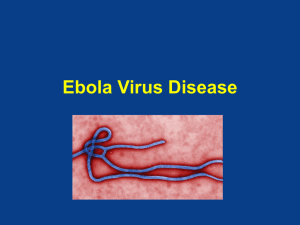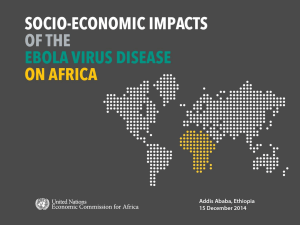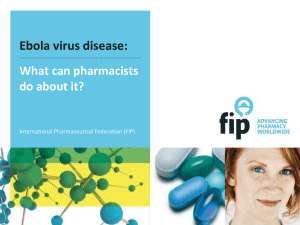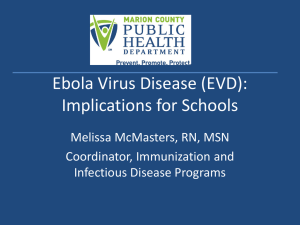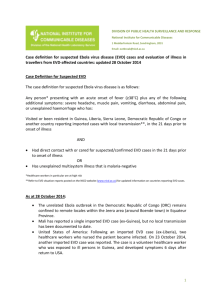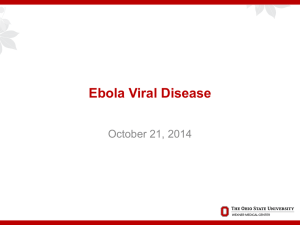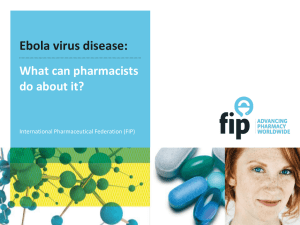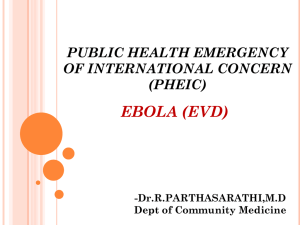Middle East Respiratory Syndrome (MERS) coronavirus
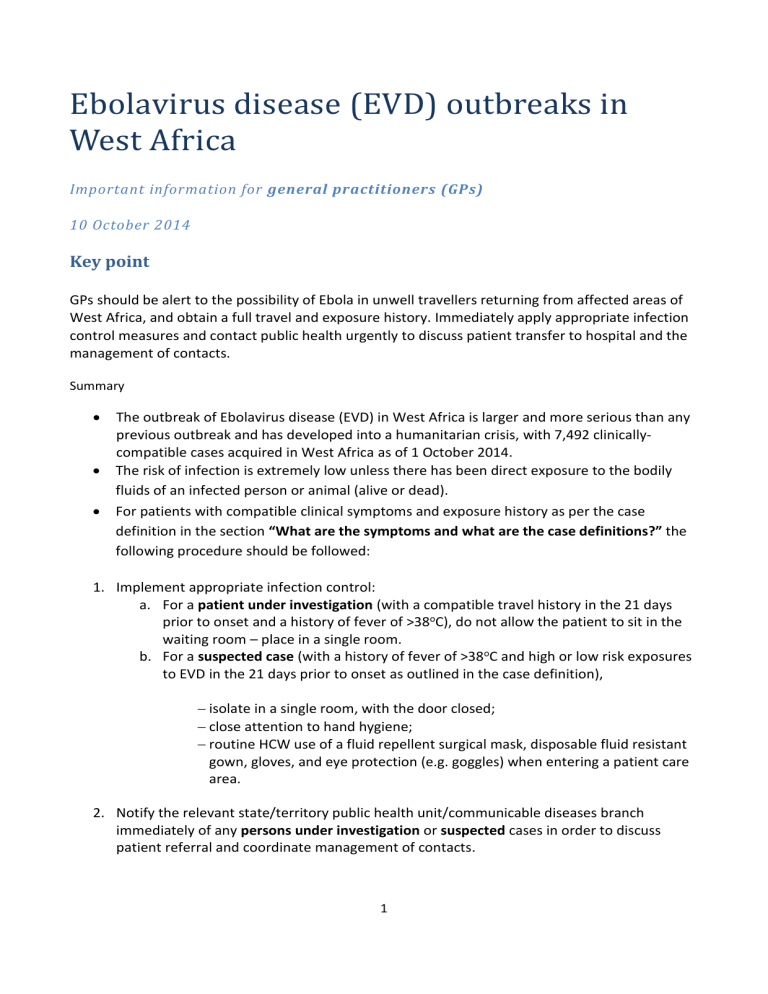
Ebolavirus disease (EVD) outbreaks in
West Africa
Important information for general practitioners (GPs)
10 October 2014
Key point
GPs should be alert to the possibility of Ebola in unwell travellers returning from affected areas of
West Africa, and obtain a full travel and exposure history. Immediately apply appropriate infection control measures and contact public health urgently to discuss patient transfer to hospital and the management of contacts.
Summary
The outbreak of Ebolavirus disease (EVD) in West Africa is larger and more serious than any previous outbreak and has developed into a humanitarian crisis, with 7,492 clinicallycompatible cases acquired in West Africa as of 1 October 2014.
The risk of infection is extremely low unless there has been direct exposure to the bodily fluids of an infected person or animal (alive or dead).
For patients with compatible clinical symptoms and exposure history as per the case definition in the section “What are the symptoms and what are the case definitions?” the following procedure should be followed:
1.
Implement appropriate infection control: a.
For a patient under investigation (with a compatible travel history in the 21 days prior to onset and a history of fever of >38 o C), do not allow the patient to sit in the waiting room – place in a single room. b.
For a suspected case (with a history of fever of >38 o C and high or low risk exposures to EVD in the 21 days prior to onset as outlined in the case definition),
isolate in a single room, with the door closed;
close attention to hand hygiene;
routine HCW use of a fluid repellent surgical mask, disposable fluid resistant gown, gloves, and eye protection (e.g. goggles) when entering a patient care area.
2.
Notify the relevant state/territory public health unit/communicable diseases branch immediately of any persons under investigation or suspected cases in order to discuss patient referral and coordinate management of contacts.
1
Map: Areas of Guinea, Liberia and Sierra Leone in West Africa affected by outbreaks of EVD as of
1 October 2014 ( from the WHO website accessed 7 October 2014 ).
What are the symptoms and what are the case definitions?
The likelihood that a febrile illness in a returned traveller is due to EVD is very low, however clinicians should be aware of the possibility of EVD in patients who meet the case definition for a person under investigation, or a suspected case. The risk of infection is extremely low even in persons with a compatible travel history, unless there has been direct exposure to the bodily fluids of an infected person (including unprotected sexual contact with confirmed cases up to three months after they have recovered) or animal (alive or dead).
The onset of symptoms is sudden and includes fever, myalgia, fatigue and headache. The next stage may include symptoms that are gastrointestinal (vomiting, diarrhoea), neurological (headaches, confusion), vascular, cutaneous (maculopapular rash), and respiratory (sore throat, cough) with prostration. Cases may develop a septic shock-like syndrome, and progress to multi-organ failure, sometimes accompanied by profuse internal and external bleeding. The case-fatality rate (CFR) for
Zaire strain of EVD cases during previous outbreaks is estimated to be between 50% and 90%, while for other species, the CFR may be lower.
Case definition
Testing should be considered for persons with epidemiological and clinical evidence as per the
Communicable Diseases Network of Australia (CDNA) case definitions:
Person under investigation
Requires clinical evidence and limited epidemiological evidence.
Note: If a risk assessment determines that a person under investigation should be tested for
Ebolavirus, the person should be managed as a suspected case from that point forward regardless of clinical and epidemiological evidence.
Suspected case
Requires clinical evidence and epidemiological evidence.
Definitions
Clinical evidence requires fever of >38 o C. Additional symptoms such as unexplained haemorrhage or bruising, severe headache, muscle pain, marked vomiting, marked diarrhoea, abdominal pain should also be considered.
Limited epidemiological evidence requires only travel to an EVD affected area (country/region)* in the 21 days prior to onset.
Epidemiological evidence requires a lower risk exposure or higher risk exposure in the 21 days prior to onset as defined below.
Lower risk exposures:
household contact with an EVD case (in some circumstances this might be classified as higher risk such where the household was in a resource poor setting),
being within approximately 1 metre of an EVD patient or within the patient’s room or care area for a prolonged period of time (e.g., healthcare workers, household members) while
not wearing recommended personal protective equipment (see “What are the recommended isolation and PPE recommendations for patients in hospital?” for details).
having direct brief contact (e.g., shaking hands) with an EVD patient while not wearing recommended personal protective equipment.
Higher risk exposures:
percutaneous (e.g. needle stick) or mucous membrane exposure to blood or body fluids of an EVD patient (either suspected or confirmed)
direct skin contact with blood or body fluids of an EVD patient without appropriate personal protective equipment (PPE),
laboratory processing of body fluids of suspected, probable, or confirmed EVD cases without appropriate PPE or standard biosafety precautions,
direct contact with a dead body without appropriate PPE in a country where an EVD outbreak is occurring,
direct handling of sick or dead animals from disease-endemic areas or consumption of
“bushmeat” in country where EVD is known to occur.
*Areas affected by outbreaks in West Africa should currently be considered to be Guinea, Liberia, and Sierra Leone, but travel to neighbouring countries in West Africa (Mali, Cote d’Ivoire, Guinea-Bissau, Senegal) and countries with limited transmission (Nigeria, Spain) should also be considered where there is strong clinical suspicion. Further, filoviruses are endemic in sub-Saharan Africa.
Reporting and further assessment
The GP must notify a suspected case immediately to their state/territory communicable disease branch/centre to discuss referral (see “Who do I contact if I have a suspected case?” for contact information).
If, following discussion with public health authorities and infectious disease physicians, it is decided that the patient does not require further assessment and/or testing for EVD, the patient should be managed as per usual practice.
Where there is clinical need for an ambulance, this should precede contact with the state/territory communicable disease branch/centre. The ambulance must be informed that the patient is under investigation for Ebola.
What are the recommended isolation and PPE recommendations for patients in general practice?
If a patient identifies to reception as being unwell and having a compatible travel or exposure history, they should not be allowed to sit in the waiting room.
For a patient under investigation (with a compatible travel history and a history of fever of >38 o C), place in a single room and use standard precautions for infection control.
For a suspected case (patients with compatible symptoms and exposure history– either a low or high risk exposure), GPs should follow standard precautions for infection control, and to minimise the risk of spread of EVD, contact and droplet precautions are used in addition to standard precautions.
The Royal Australasian College of General practitioners (RACGP) provides infection control standards for office-based practice (http://www.racgp.org.au/yourpractice/standards/infectioncontrol/).
In summary, contact and droplet precautions for use in general practice should include:
placement of the patient in a single room, with the door closed.
close attention to hand hygiene; and
routine HCW use of a fluid repellent surgical mask, disposable fluid resistant gown, gloves, and eye protection (e.g. goggles) when entering a patient care area.
Where the required PPE is not available, options to reduce the risk include maintaining a distance of >1m from the patient while obtaining further details about their clinical and exposure history.
Prior to placing the patient in a single room, remove all unnecessary objects and equipment from that room to minimise the complexity of cleaning and decontaminating after the patient has been transferred out if they later test positive for EVD.
Information about environmental cleaning is available in the CDNA Series of National Guidelines
(SoNG) for public health units on Ebola, the Ebola SoNG (section 10 and appendix 12).
Are health workers at risk from EVD?
Caring for ill relatives is a known risk factor for infection, and healthcare workers, particularly those in resource poor settings with inadequate infection control are also at risk.
Pre-travel advice for travellers
The Department of Foreign Affairs and Trade has advised Australians to reconsider their need to travel to affected countries in Africa. More information can be found on the Smartraveller website
GPs should advise patients that the current outbreak of EVD has overwhelmed many local health facilities and if they become ill while in these countries the options for obtaining routine or emergency medical care may be severely limited. The Department of Foreign Affairs and Trade has advised that medical evacuations for any potential EVD patient – and particularly symptomatic EVD patients - will be extremely difficult, if not impossible, to conduct.
For unavoidable travel, GPs should emphasise the general low risk, but that travellers should avoid direct exposure to the bodily fluids of an infected person or animal (alive or dead), including unprotected sexual contact with patients up to three months after they have recovered. GPs should advise travellers to ensure that if they are in the region for work, that their employer has relevant
contingency plans, and if they travel to the region independently, they should ensure that their travel insurance will cover medical evacuation and treatment if necessary.
If a traveller becomes unwell while in transit they should advise airline staff or border officers.
Who do I contact if I have a suspected case?
Contact your state/territory communicable disease branch/centre.
SA
TAS
VIC
WA
State/territory Public health unit contact details
ACT
NSW
NT
QLD
02 6205 2155
1300 066 055
Contact details for the public health offices in NSW Local Health Districts
(http://www.health.nsw.gov.au/Infectious/Pages/phus.aspx)
08 8922 8044 Monday-to Friday daytime and 08 8922 8888 ask for CDC doctor on call –for after hours
13 432 584
Contact details for the public health offices in QLD Area
(www.health.qld.gov.au/cdcg/contacts.asp)
1300 232 272
1800 671 738
1300 651 160
08 9388 4801 After hours 08 9328 0553
Contact details for the public health offices in WA
(www.public.health.wa.gov.au/3/280/2/contact_details_for_regional_populat ion__public_he.pm)
How do I test for EVD?
Testing for EVD is not normally conducted in a general practice setting and patients should be notified and referred as per the previous section.
Advice for contacts of cases
The state/territory communicable disease branch or public health units will undertake the public health management of contacts of suspected, probable and confirmed cases. Contacts of cases should be directed to your state/territory communicable disease branch/centre for management.
Background information
Ebolaviruses
Ebolaviruses are part of the family Filoviridae, which also includes Marburg virus. Fruit bats of the
Pteropodidae family are considered to be a likely natural host of the Ebolavirus, with outbreaks amongst other species such as chimpanzees, gorillas, monkeys and forest antelope from time to time. Five species of Ebolavirus have been identified, namely Zaire, Sudan, Reston, Tai Forest and
Bundibugyo, but Reston and Tai Forest species are not known to have caused outbreaks amongst humans.
Transmission
Ebolavirus is introduced into the human population through direct contact (through mucous membranes or broken skin) with the blood, secretions, or other bodily fluids of infected animals
(often therefore through hunting or preparation of "bushmeat"). In Africa, infection has been documented through the handling of infected chimpanzees, gorillas, fruit bats, monkeys, forest antelope and porcupines found ill or dead or in the rainforest.
Ebolavirus then spreads through person-to-person transmission via direct contact (through mucous membranes or broken skin) with:
the blood or bodily fluids (including but not limited to urine, saliva, feces, vomit, and semen) of people with EVD, and the bodies of people who have died of EVD.
objects (e.g. needles, syringes) contaminated with blood or bodily fluids of people with
EVD.
Transmission through sexual contact may be possible for up to three months after clinical recovery.
Participating in traditional burial ceremonies in affected areas of Africa is a known high risk activity for transmission.
The risk of transmission in healthcare settings can be significantly reduced through the use of appropriate infection control precautions and environmental cleaning.
Airborne transmission to humans, as occurs for tuberculosis or measles, has never been documented.
Incubation period
From 2 to 21 days; most commonly 8 to 10 days.
Treatment
There are no specific prophylactic (vaccine) or therapeutic (antiviral drugs) options available to treat human infections, and care is largely supportive.
Quarantinable disease
EVD is a quarantinable disease in Australia, and as such can be controlled and eradicated through a range of quarantine measures, including enforcing appropriate quarantine measures if suspected cases of disease are identified.
What is happening at the border?
Australian health authorities are closely monitoring this disease outbreak overseas and our border protection agencies are alert to watch for people who are unwell both inflight and at airports. As part of routine procedures, incoming flights to Australia have on-board announcements, asking passengers who are feeling unwell with fever, chills or sweats to alert a crew member. Crew members would alert border officers for health follow up.
All airport border agencies are aware of the Ebola outbreak and have been provided guidance by the Department of Health to identify any passengers presenting Ebola symptoms in flights or at airports. Border officers also provide information and advice to passengers at the border who are unsure of what they should do if they are feeling ill. The health of people who have originated their travel from affected parts of West Africa is being checked.
The Australian Government will continue to closely monitor the situation overseas and will continue to assess the efficacy of our border measures.
Situation update
The following information is about the outbreak in West Africa at the time of writing, and does not necessarily reflect the areas of risk to be considered in a clinical risk assessment.
Table 1. Number of clinical, confirmed and fatal cases of Ebolavirus disease acquired in West
Africa as of 1 October 2014 (data for Liberia as at 30 September 2014), by country. WHO
Roadmap situation update 8 October 2014, data as of 3 October 2014 (data as of 8 October for
Spain and as of 10 October for United States of America)
Country
Countries with widespread and intense transmission
Guinea
Liberia
Sierra Leone
Countries with imported cases or limited transmission
Nigeria
Senegal
Spain
United States of America
Total
Clinical cases
Confirmed cases
Deaths
Notes
1298
3924
2789
1044 768
941 2210
2455 879
20
1
1
1
8034
19
1
1
1
4462
8
0
0
1
3865
Last case 5 Sept
2014
Last case 28 Aug
2014
Reported 6 Oct
2014
Reported 30 Sept
2014
A separate outbreak was first reported on 26 August 2014 in the Democratic Republic of the Congo, with 70 clinical cases, of which 30 have been laboratory confirmed and 43 have died, but there have been no reports of new cases since 28 September 2014.
Figure: Clinical cases of Ebolavirus disease in Guinea, Liberia and Sierra Leone, by week reported
by the World Health Organization. WHO updates 23 March to 3 October 2014.
See the WHO website (http://www.who.int/csr/don/en/) for the latest information
Further advice
CDNA Series of National Guidelines (SoNG) for public health units on Ebola, available from the
Department of Health website (www.health.gov.au/ebola)
WHO situation updates and resources for health professionals are available from the WHO website
(http://www.who.int/csr/disease/ebola/en/)
Surveillance case definition for confirmed and probable cases, available from the Department of
Health website ( http://www.health.gov.au/internet/main/publishing.nsf/Content/cda-surveil-nndsscasedefs-cd_vhf.htm
)
